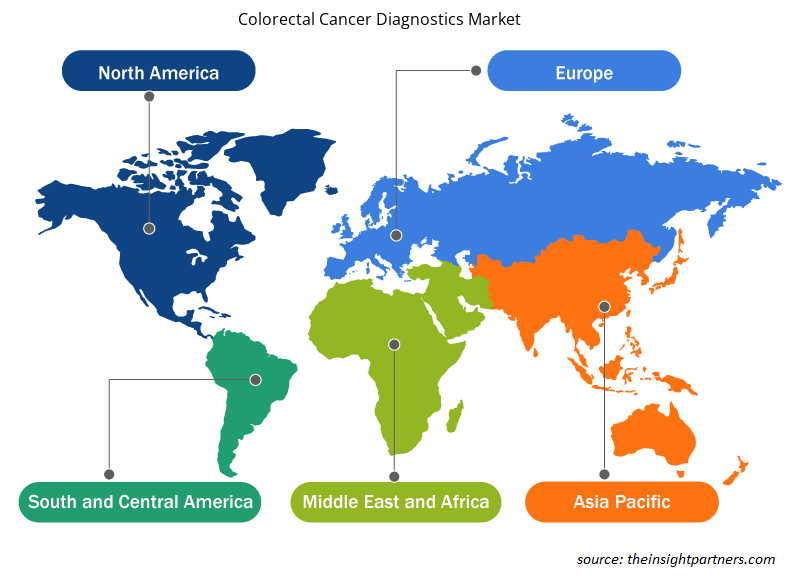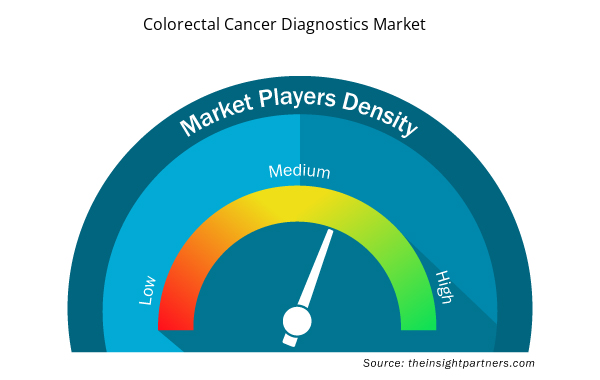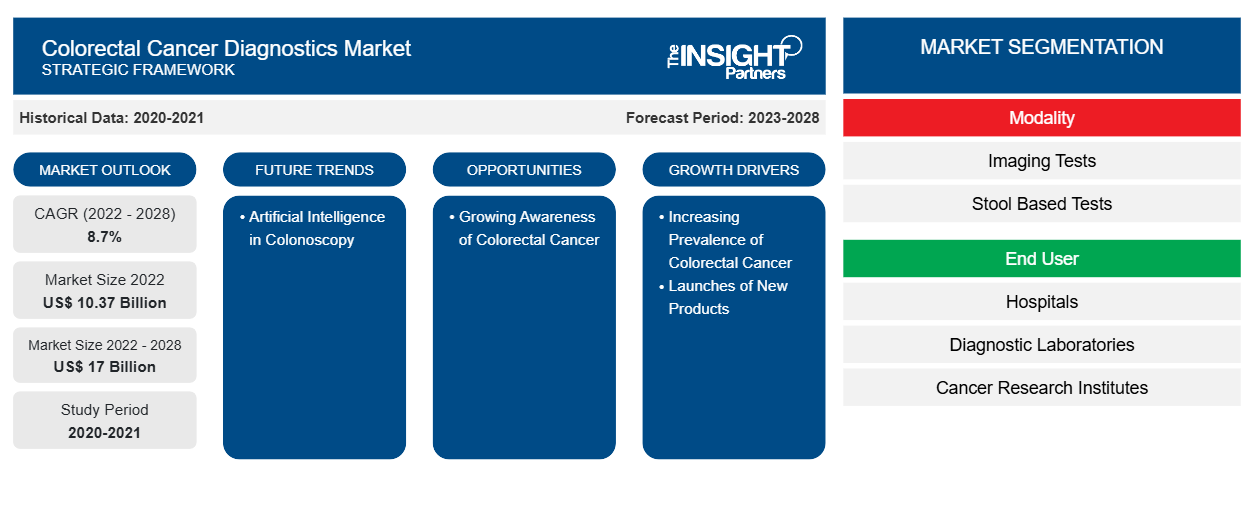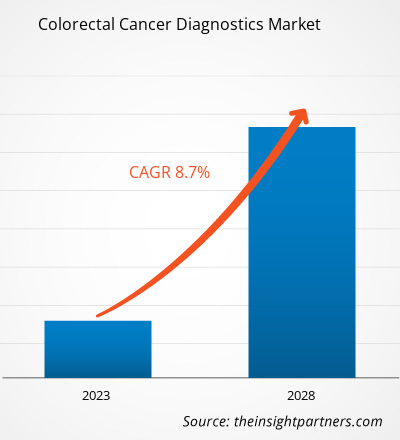[Rapport de recherche] La taille du marché du diagnostic du cancer colorectal devrait passer de 10 374,68 millions USD en 2022 à 16 996,48 millions USD d'ici 2028 ; elle devrait enregistrer un TCAC de 8,7 % de 2023 à 2028.
Le marché du diagnostic du cancer colorectal est segmenté en fonction de la modalité, de l'utilisateur final et de la géographie. Le rapport offre des informations et une analyse approfondie du marché, en mettant l'accent sur des paramètres tels que les moteurs, les tendances, les opportunités et l'analyse du paysage concurrentiel des principaux acteurs du marché dans diverses régions. Il comprend également des analyses de l'impact de la pandémie de COVID-19 dans les principales régions.
Informations sur le marché
Les lancements de nouveaux produits stimulent la croissance colorectale
Les principaux acteurs du marché du diagnostic du cancer colorectal fabriquent une large gamme d'appareils qui aident à réduire le fardeau du cancer colorectal et d'autres indications associées telles que les polypes du côlon, la maladie de Crohn, la colite et le syndrome du côlon irritable. En juillet 2022, US Digestive Health (USDH), un réseau de cabinets gastro-intestinaux (GI) de premier ordre, a annoncé la commercialisation de dépistages par coloscopie assistée par IA avec la plus grande installation du pays de modules d'endoscopie GI intelligents Genious. Ces modules devraient aider les médecins à identifier en temps réel les polypes difficiles à détecter et potentiellement cancéreux. Avec le lancement de cet appareil, les patients du sud-est, du sud-ouest et du centre de la Pennsylvanie peuvent désormais accéder à une coloscopie assistée par IA avec des capacités améliorées. En septembre 2020, Olympus Corporation a annoncé le lancement d'ENDO-AID, une plateforme de pointe alimentée par l'intelligence artificielle (IA). La plateforme comprend l'application ENDO-AID CADe (app), une méthode endoscopique assistée par ordinateur pour la détection de différentes affections du côlon. Cette nouvelle plateforme d'IA permet l'affichage en temps réel des lésions suspectes détectées automatiquement et fonctionne en combinaison avec son EVIS X1. Ainsi, les développements fréquents et les lancements de nouveaux produits stimulent la croissance du marché du diagnostic du cancer colorectal.
Personnalisez ce rapport en fonction de vos besoins
Vous bénéficierez d'une personnalisation gratuite de n'importe quel rapport, y compris de certaines parties de ce rapport, d'une analyse au niveau des pays, d'un pack de données Excel, ainsi que d'offres et de remises exceptionnelles pour les start-ups et les universités.
- Obtenez les principales tendances clés du marché de ce rapport.Cet échantillon GRATUIT comprendra une analyse de données, allant des tendances du marché aux estimations et prévisions.
Informations basées sur les modalités
En fonction de la modalité, le marché du diagnostic du cancer colorectal est divisé en tests basés sur les selles et tests d'imagerie. En 2022, le segment des tests d'imagerie détenait une part plus importante du marché du diagnostic du cancer colorectal et devrait enregistrer un TCAC plus élevé au cours de la période de prévision. L'utilisation des tests d'imagerie dans le diagnostic du cancer colorectal a évolué au cours des dernières années. Les résultats d'imagerie jouent un rôle essentiel dans la surveillance, le diagnostic, la stadification, la sélection du traitement et la planification du suivi. Les tests d'imagerie consistent à examiner la structure du côlon et du rectum pour détecter la présence de zones anormales. Les examens d'imagerie utilisent des endoscopes, des instruments en forme de tube avec une lumière et une petite caméra vidéo à leur extrémité, insérés dans le rectum. Ces tests scannent l'intérieur du côlon et du rectum à la recherche de zones anormales qui pourraient être un cancer ou des polypes. Ces tests sont utilisés moins souvent que les tests basés sur les selles et nécessitent plus de préparation au préalable et comportent certains risques associés, contrairement aux tests basés sur les selles. Les examens d'imagerie sont en outre classés en coloscopie, colographie CT, sigmoïdoscopie flexible, endoscopie par capsule et autres.
Le segment de la coloscopie détenait la plus grande part du marché en 2022. Cependant, la coloscopie par tomodensitométrie devrait croître à un rythme plus rapide au cours de la période de prévision. La coloscopie par tomodensitométrie aide à l'analyse morphologique des déformations de la paroi, fournissant les informations nécessaires à l'évaluation préopératoire de la stadification T dans le cancer colorectal. Conformément aux directives des critères d'évaluation de la réponse dans les tumeurs solides (RECIST), la tomodensitométrie est la modalité la plus largement utilisée pour évaluer la réponse au traitement chez les patients atteints de tumeurs métastasées du côlon et du rectum. Les avantages communs de la coloscopie par tomodensitométrie sont les suivants : elle est rapide et sûre, elle permet de visualiser l'ensemble du côlon et aucune sédation n'est nécessaire pour effectuer le test. Il est recommandé de réaliser ce test tous les cinq ans chez les patients asymptomatiques présentant un risque moyen.
Informations basées sur l'utilisateur final
En fonction de l'utilisateur final, le marché du diagnostic du cancer colorectal est segmenté en hôpitaux, laboratoires de diagnostic, instituts de recherche sur le cancer et autres. Le segment des hôpitaux représentait la plus grande part de marché en 2022 et devrait enregistrer le TCAC le plus élevé au cours de la période de prévision.
Les acteurs du marché du diagnostic du cancer colorectal adoptent des stratégies organiques telles que le lancement et l'expansion de produits pour étendre leur empreinte géographique et leurs portefeuilles de produits et répondre aux demandes croissantes. Les stratégies de croissance inorganique adoptées par les acteurs du marché leur permettent d'étendre leurs activités et d'améliorer leur présence géographique. De plus, ces stratégies de croissance aident les entreprises à renforcer leur clientèle et à élargir leur portefeuille de produits.
- En décembre 2022, Epigenomics a obtenu une licence pour une technologie de biomarqueurs protéiques pour le test sanguin du cancer colorectal. La société a obtenu une licence du MD Anderson Cancer Center de l'Université du Texas pour certains droits de brevet et de technologie sur des biomarqueurs associés à la détection du cancer colorectal.
- En août 2021, Illumina a acquis GRAIL pour accélérer l'accès des patients à un test de détection précoce de plusieurs cancers qui leur sauve la vie. Le test sanguin Galleri de GRAIL détecte 50 cancers différents avant qu'ils ne deviennent symptomatiques. L'acquisition de GRAIL par Illumina accélérera l'accès et l'adoption de ce test qui sauve des vies dans le monde entier.
Aperçu régional du marché du diagnostic du cancer colorectal
Les tendances et facteurs régionaux influençant le marché du diagnostic du cancer colorectal tout au long de la période de prévision ont été expliqués en détail par les analystes d’Insight Partners. Cette section traite également des segments et de la géographie du marché du diagnostic du cancer colorectal en Amérique du Nord, en Europe, en Asie-Pacifique, au Moyen-Orient et en Afrique, ainsi qu’en Amérique du Sud et en Amérique centrale.

- Obtenez les données régionales spécifiques au marché du diagnostic du cancer colorectal
Portée du rapport sur le marché du diagnostic du cancer colorectal
| Attribut de rapport | Détails |
|---|---|
| Taille du marché en 2022 | 10,37 milliards de dollars américains |
| Taille du marché d'ici 2028 | 17 milliards de dollars américains |
| Taux de croissance annuel composé mondial (2022-2028) | 8,7% |
| Données historiques | 2020-2021 |
| Période de prévision | 2023-2028 |
| Segments couverts | Par modalité
|
| Régions et pays couverts | Amérique du Nord
|
| Leaders du marché et profils d'entreprises clés |
|
Densité des acteurs du marché du diagnostic du cancer colorectal : comprendre son impact sur la dynamique commerciale
Le marché du diagnostic du cancer colorectal connaît une croissance rapide, tirée par la demande croissante des utilisateurs finaux en raison de facteurs tels que l'évolution des préférences des consommateurs, les avancées technologiques et une plus grande sensibilisation aux avantages du produit. À mesure que la demande augmente, les entreprises élargissent leurs offres, innovent pour répondre aux besoins des consommateurs et capitalisent sur les tendances émergentes, ce qui alimente davantage la croissance du marché.
La densité des acteurs du marché fait référence à la répartition des entreprises ou des sociétés opérant sur un marché ou un secteur particulier. Elle indique le nombre de concurrents (acteurs du marché) présents sur un marché donné par rapport à sa taille ou à sa valeur marchande totale.
Les principales entreprises opérant sur le marché du diagnostic du cancer colorectal sont :
- Medtronic Plc
- Illumina Inc
- Technologies de génomique clinique Pty Ltd
- EDP Biotech Corp
- Epigénomique AG
Avis de non-responsabilité : les sociétés répertoriées ci-dessus ne sont pas classées dans un ordre particulier.

- Obtenez un aperçu des principaux acteurs du marché du diagnostic du cancer colorectal
Profils d'entreprise
- Medtronic Plc
- Illumina Inc
- Technologies de génomique clinique Pty Ltd
- EDP Biotech Corp
- Epigénomique AG
- F. Hoffmann-La Roche SARL
- Quest Diagnostics Inc
- Novigenix SA
- Siemens Healthineers SA
- Société Bruker
- Eiken Chemical Co., Ltd.
- Analyse historique (2 ans), année de base, prévision (7 ans) avec TCAC
- Analyse PEST et SWO
- Taille du marché Valeur / Volume - Mondial, Régional, Pays
- Industrie et paysage concurrentiel
- Ensemble de données Excel


- Clear Aligners Market
- Europe Surety Market
- Parking Management Market
- Integrated Platform Management System Market
- Resistance Bands Market
- Medical and Research Grade Collagen Market
- Sports Technology Market
- Ceramic Injection Molding Market
- Pressure Vessel Composite Materials Market
- Medical Audiometer Devices Market

Report Coverage
Revenue forecast, Company Analysis, Industry landscape, Growth factors, and Trends

Segment Covered
This text is related
to segments covered.

Regional Scope
North America, Europe, Asia Pacific, Middle East & Africa, South & Central America

Country Scope
This text is related
to country scope.
Questions fréquemment posées
Colorectal cancer diagnostics refers to the tools, kits and test performed on an individual to diagnose colorectal cancer in an individual. This involves series of non-invasive and invasive test to confirm the cancer and its stage based on that treatment will be provided to the patient.
Asia Pacific is expected to be the fastest growing region in the colorectal cancer diagnostics market. Asia Pacific registered as the fastest-growing region in the global colorectal cancer diagnostics market. The market in this region is driven due to rising incidences of colorectal cancer, easy access to the diagnosis for colorectal cancer, and proposing guidelines for the procedures. Also, increasing government funding for research activities in colorectal cancer is expected to propel the growth of the market for colorectal cancer diagnostics in Asia Pacific.
The colorectal cancer diagnostics market, based on modality, is bifurcated into imaging tests and stool based tests. In 2022, the imaging tests segment held the larger share and is expected to grow at a CAGR of 8.8% during the forecast period. Screening and imaging play a vital role in the diagnostics of colorectal cancer to understand the extent of tumor-affected area, that act as a major driving factor for the growth of the imaging tests segment.
The factors that are driving growth of the market are increasing prevalence of colorectal cancer and launches of new products.
The US holds the largest market share in colorectal cancer diagnostics market. The growth of the market in the country is because in 2022, more than 600,000 surgeries are performed annually in the US to treat colon diseases. According to the American Cancer Society, the 5-year survival rate for localized colon cancer is 91% and for localized rectal cancer is 90%.
The colorectal cancer diagnostics market majorly consists of the players such as Medtronic Plc, Illumina Inc, Clinical Genomics Technologies Pty Ltd, EDP Biotech Corp, Epigenomics AG, F Hoffmann-La Roche Ltd, Quest Diagnostics Inc, Novigenix SA, Siemens Healthineers AG, Bruker Corp, and Eiken Chemical Co Ltd.
Trends and growth analysis reports related to Life Sciences : READ MORE..
The List of Companies - Colorectal Cancer Diagnostics Market
- Medtronic Plc
- Illumina Inc
- Clinical Genomics Technologies Pty Ltd
- EDP Biotech Corp
- Epigenomics AG
- F. Hoffmann-La Roche Ltd
- Quest Diagnostics Inc
- Novigenix SA
- Siemens Healthineers AG
- Bruker Corp
- Eiken Chemical Co., Ltd.
The Insight Partners performs research in 4 major stages: Data Collection & Secondary Research, Primary Research, Data Analysis and Data Triangulation & Final Review.
- Data Collection and Secondary Research:
As a market research and consulting firm operating from a decade, we have published and advised several client across the globe. First step for any study will start with an assessment of currently available data and insights from existing reports. Further, historical and current market information is collected from Investor Presentations, Annual Reports, SEC Filings, etc., and other information related to company’s performance and market positioning are gathered from Paid Databases (Factiva, Hoovers, and Reuters) and various other publications available in public domain.
Several associations trade associates, technical forums, institutes, societies and organization are accessed to gain technical as well as market related insights through their publications such as research papers, blogs and press releases related to the studies are referred to get cues about the market. Further, white papers, journals, magazines, and other news articles published in last 3 years are scrutinized and analyzed to understand the current market trends.
- Primary Research:
The primarily interview analysis comprise of data obtained from industry participants interview and answers to survey questions gathered by in-house primary team.
For primary research, interviews are conducted with industry experts/CEOs/Marketing Managers/VPs/Subject Matter Experts from both demand and supply side to get a 360-degree view of the market. The primary team conducts several interviews based on the complexity of the markets to understand the various market trends and dynamics which makes research more credible and precise.
A typical research interview fulfils the following functions:
- Provides first-hand information on the market size, market trends, growth trends, competitive landscape, and outlook
- Validates and strengthens in-house secondary research findings
- Develops the analysis team’s expertise and market understanding
Primary research involves email interactions and telephone interviews for each market, category, segment, and sub-segment across geographies. The participants who typically take part in such a process include, but are not limited to:
- Industry participants: VPs, business development managers, market intelligence managers and national sales managers
- Outside experts: Valuation experts, research analysts and key opinion leaders specializing in the electronics and semiconductor industry.
Below is the breakup of our primary respondents by company, designation, and region:

Once we receive the confirmation from primary research sources or primary respondents, we finalize the base year market estimation and forecast the data as per the macroeconomic and microeconomic factors assessed during data collection.
- Data Analysis:
Once data is validated through both secondary as well as primary respondents, we finalize the market estimations by hypothesis formulation and factor analysis at regional and country level.
- Macro-Economic Factor Analysis:
We analyse macroeconomic indicators such the gross domestic product (GDP), increase in the demand for goods and services across industries, technological advancement, regional economic growth, governmental policies, the influence of COVID-19, PEST analysis, and other aspects. This analysis aids in setting benchmarks for various nations/regions and approximating market splits. Additionally, the general trend of the aforementioned components aid in determining the market's development possibilities.
- Country Level Data:
Various factors that are especially aligned to the country are taken into account to determine the market size for a certain area and country, including the presence of vendors, such as headquarters and offices, the country's GDP, demand patterns, and industry growth. To comprehend the market dynamics for the nation, a number of growth variables, inhibitors, application areas, and current market trends are researched. The aforementioned elements aid in determining the country's overall market's growth potential.
- Company Profile:
The “Table of Contents” is formulated by listing and analyzing more than 25 - 30 companies operating in the market ecosystem across geographies. However, we profile only 10 companies as a standard practice in our syndicate reports. These 10 companies comprise leading, emerging, and regional players. Nonetheless, our analysis is not restricted to the 10 listed companies, we also analyze other companies present in the market to develop a holistic view and understand the prevailing trends. The “Company Profiles” section in the report covers key facts, business description, products & services, financial information, SWOT analysis, and key developments. The financial information presented is extracted from the annual reports and official documents of the publicly listed companies. Upon collecting the information for the sections of respective companies, we verify them via various primary sources and then compile the data in respective company profiles. The company level information helps us in deriving the base number as well as in forecasting the market size.
- Developing Base Number:
Aggregation of sales statistics (2020-2022) and macro-economic factor, and other secondary and primary research insights are utilized to arrive at base number and related market shares for 2022. The data gaps are identified in this step and relevant market data is analyzed, collected from paid primary interviews or databases. On finalizing the base year market size, forecasts are developed on the basis of macro-economic, industry and market growth factors and company level analysis.
- Data Triangulation and Final Review:
The market findings and base year market size calculations are validated from supply as well as demand side. Demand side validations are based on macro-economic factor analysis and benchmarks for respective regions and countries. In case of supply side validations, revenues of major companies are estimated (in case not available) based on industry benchmark, approximate number of employees, product portfolio, and primary interviews revenues are gathered. Further revenue from target product/service segment is assessed to avoid overshooting of market statistics. In case of heavy deviations between supply and demand side values, all thes steps are repeated to achieve synchronization.
We follow an iterative model, wherein we share our research findings with Subject Matter Experts (SME’s) and Key Opinion Leaders (KOLs) until consensus view of the market is not formulated – this model negates any drastic deviation in the opinions of experts. Only validated and universally acceptable research findings are quoted in our reports.
We have important check points that we use to validate our research findings – which we call – data triangulation, where we validate the information, we generate from secondary sources with primary interviews and then we re-validate with our internal data bases and Subject matter experts. This comprehensive model enables us to deliver high quality, reliable data in shortest possible time.


 Obtenez un échantillon gratuit pour ce rapport
Obtenez un échantillon gratuit pour ce rapport